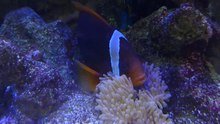 https://upload.wikimedia.org/wikipedia/commons/b/be/Amphiprion_frenatus_2016_8_29.webm
https://upload.wikimedia.org/wikipedia/commons/b/be/Amphiprion_frenatus_2016_8_29.webm
“It’s a very variable group of sea anemones in terms of how it looks — it can be fat or skinny; big or small,” Glon said. “Divers love it because it can be really striking when you see a whole bunch of them together.”
They may look like vibrant, underwater gardens — sea anemones are actually named after the “anemone” flower — but Metridium is far from plant life. Covered in venomous cells, the marine animals spend their days patiently waiting for fish and other small organisms to swim close enough to become trapped in their toxic herself, Glon has become quite familiar with the colorful creatures, which are generally harmless to humans. Many of her 100+ dives around the world have been tailored to searching for Metridium (also known as plumose anemones), including expeditions along the coasts of Japan, Ireland, Norway, the Canadian Maritimes and the Northeastern U.S., among others. She holds Advanced, Rescue and Master Scuba Diver certifications and has dove to depths of up to 100 feet.
She is looking at genetic data from the anemone samples she’s acquired, in addition to those collaborators have sent her, “to determine which species came from which oceans originally; how much connection there is between both sides of the Atlantic; how many total species there are, etc.,” she said. “There are a lot of questions that we’re looking at.”
Most recently, Glon and Daly took their anemone hunt to Iceland off the coasts of Reykjavik and Hjalteyri.
“We have really good representation from both sides of the Atlantic, but nothing from the middle, so we needed to fill in that huge gap. Iceland was hugely important to sample,” Glon said.
The team began their Icelandic excursion by looking for Metridium growing on manmade surfaces like piers and floating docks — where the anemones can nearly always be found.
“These guys really like hard substrate, so rocks and docks and piers and everything else. They don’t do well in sand,” Glon explained.